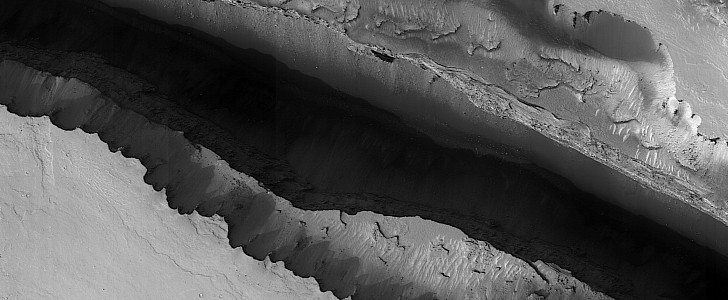Earth is a beautiful place, a planet we humans have explored extensively, but one that still holds a lot of secrets. There are now close to eight billion of us roaming the place, and even that isn’t enough when it comes to truly understanding the blue marble we’re living on.
What hope is then for us to truly grasp a place like Mars, with just a trio of rovers currently on the surface and a slightly larger bunch of spacecraft in orbit? Not much of it, probably, but that isn’t stopping us, humans, from trying to at least get a proper representation of the place before actually going there.
One way to do that is to survey the planet from above. Since 2006, a ship called Mars Reconnaissance Orbiter has been doing that, and one of its instruments, the HiRISE camera, has sent back to Earth over the years about 70,000 images of the Red Planet.
Some of them we can understand and explain, but there are quite a lot that show mysterious (in one way or another) features. Others, like the one we have here, can be explained, but still have the power to dazzle the onlooker.
The almost perfectly straight (on one side) gash we see here seems like it was made using some kind of precision cutting instrument, like a laser or some such.
In fact, it’s a wound left on the surface of the planet by faults pulling the crust apart, not unlike we get to see in disaster movies here on Earth. The feature is located in the Cerberus Fossae region of the planet.
The image was taken by HiRISE from an altitude of 277 km (172 miles) back in 2011, and it shows an area less than five km (three miles) across, making the gash quite large.
As per the scientists studying the planet through these images, the fracture, as it’s officially called, may have at one point “acted as a conduit for the release of water and lava onto the surface.”
One way to do that is to survey the planet from above. Since 2006, a ship called Mars Reconnaissance Orbiter has been doing that, and one of its instruments, the HiRISE camera, has sent back to Earth over the years about 70,000 images of the Red Planet.
Some of them we can understand and explain, but there are quite a lot that show mysterious (in one way or another) features. Others, like the one we have here, can be explained, but still have the power to dazzle the onlooker.
The almost perfectly straight (on one side) gash we see here seems like it was made using some kind of precision cutting instrument, like a laser or some such.
In fact, it’s a wound left on the surface of the planet by faults pulling the crust apart, not unlike we get to see in disaster movies here on Earth. The feature is located in the Cerberus Fossae region of the planet.
The image was taken by HiRISE from an altitude of 277 km (172 miles) back in 2011, and it shows an area less than five km (three miles) across, making the gash quite large.
As per the scientists studying the planet through these images, the fracture, as it’s officially called, may have at one point “acted as a conduit for the release of water and lava onto the surface.”








